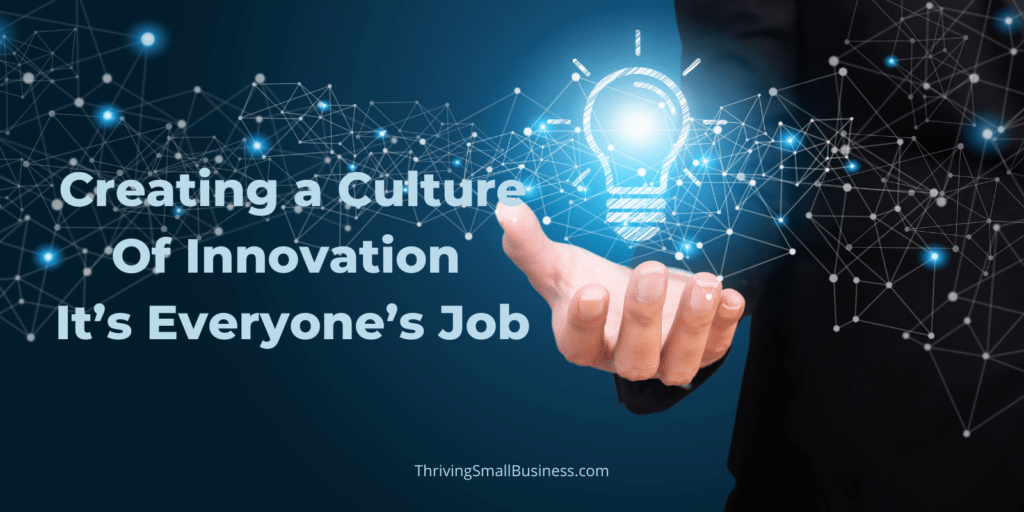Creating a Culture of Innovation – It’s Everyone’s Job
Estimated reading time: 4 minutes
Most businesses deal with the constant struggle of beating the competition.
Successful organizations have learned that to stay a step ahead of their competitors, they need to develop new and creative products and services constantly.
Gone are the days when the board, CEO, or operations manager takes responsibility for innovation. Instead, it is becoming more common for organizations to incorporate innovation into the way work is done.
A recent Harvard Business Review Article discusses how innovation is becoming ingrained into the fabric of many organizations’ day-to-day work.
To help with this, many of these organizations are using innovation black belts to help teach and operate with key principles of innovation.
Creating new products and services requires risk-taking, which often leads to failure. And, as we shift our thinking, we soon recognize that innovation requires failure.
This trial and error process fulfills the ultimate goal, which is to create something that can be improved over time – resulting in a desirable end product.
At this stage of development is where testing, feedback, remaking, and testing happens all over again.
There are five requirements for a company to be truly innovative:
1. Employees are Taught to Think like Innovators
This is a major change in thinking from years past – when employees did what they were told and were asked NOT to ask questions!
For employees to think like an innovator, they need to be given the freedom to think, explore, and challenge the status quo.
To do this, employees are taught:
- To challenge the invisible orthodoxies – is there a better way of doing this?
- Harness under-appreciated trends – what are the newest trends that we can take advantage of?
- Leverage embedded competencies and assets – identify our greatest skills and assets and build products around them.
- Address unarticulated customer needs – study customer behaviors to learn how to better meet their needs.
Employees need to learn how to master these skills by thinking like an innovator.
2. A Shared Definition of Innovation
Employees need to understand what it means to be innovative and how it relates to their own work environment.
This is important because it is difficult to know that you hit the mark unless you understand your aim.

For Whirlpool, a company known for its innovative practices, innovation is defined as:
- It must be unique and compelling to the consumer,
- Create a competitive advantage,
- Sit on a migration path that can yield further innovations,
- Provide consumers with more value than anything else in the market.
This articulated definition makes it easier to plan, allocate resources, set target goals, and measure the success of innovation.
3. Comprehensive Innovation Metrics
To know if your innovation efforts are successful, you need to figure out how to measure what you are doing.
Innovation metrics can be things like:
- Inputs: time and money invested in innovation as well as the number of ideas generated each month.
- Throughput: the number and quality of ideas generated and the time it takes to develop the concept into a prototype.
- Outputs: the number of new products and services, revenue, and margin gains due to innovation.
- Leadership: the time executives devote to mentoring innovation projects and how they are perceived as demonstrating pro-innovation behaviors.
- Competence: the number of trained business innovators, innovation black belts, and the quality of innovative ideas being generated.
- Climate: the way management processes facilitate or frustrate innovation and the ability to remove innovation blockages.
- Efficiency: the ratio of innovation outputs to inputs.
- Balance: the mix of different types of innovation, risk categories, and different time horizons.
4. Accountable and Capable Innovative Leaders
This means developing a leadership team that can facilitate and nurture innovation within the day-to-day work.
These managers need to understand the tools used to innovate, and they hire, promote, and train employees on innovation principles.
They do this by fostering brainstorming and creating opportunities for employees to think and dream – and ultimately create.
5. Innovation Friendly Management Processes
These processes include screening job applicants and hiring with innovation in mind, budgeting for innovation projects, and creating systems to reward and compensate for innovation, tracking innovation investments, and staffing.
The re-engineering that was done decades ago to help businesses streamline their internal systems and processes now needs to be done to overhaul the way organizations are thinking about innovation.
Including how they budget, manage, and compensate employees to encourage innovation.
Those who are successful will be able to create unique products and services that will ultimately help them stay ahead of the competition.
If you would like to learn more about how Whirlpool did it, you can check out the book Unleashing Innovation: How Whirlpool Transformed an Industry.
What does your business do to innovate?






